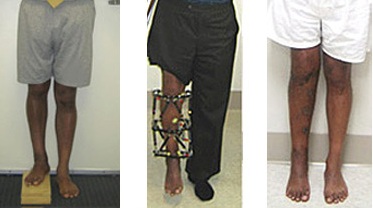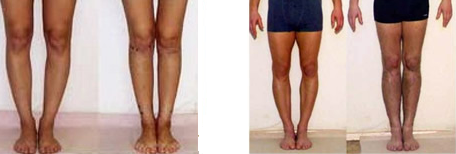How Does It Work?
The limb lengthening process works by gradually growing new bone and soft tissues (skin, muscle, nerves, blood vessels, etc). This new growth is called tissue regeneration.
Bone and soft tissue regenerate when they are distracted (pulled apart) at a very slow rate of approximately 1 mm per day. If the rate of distraction is faster than this, bone may fail to form between the two ends of the bone that are being pulled apart. Then, soft tissues, such as muscle, may experience contracture (get too tight) or nerves may become paralyzed. If the rate of distraction is too slow, premature consolidation may occur (the bone may consolidate too soon), preventing the lengthening device from further pulling it apart.
There are many different lengthening devices used. The most common are external fixators, which are devices that attach to the bone by means of thin wires or thicker pins that have a screw threading at their attachment to the bone. There are also lengthening devices that are fully implanted inside the bone. These devices do not require external pins. The different devices are described separately.
There are two phases of lengthening until the bone is fully healed: the distraction phase and the consolidation phase. The distraction phase is the lengthening phase. After the desired length is obtained, the newly regenerated bone is still very weak because of lack of calcium within it. The hardening and calcification of this new bone is called the consolidation phase.
METHODS OF LENGTHENING:-
A variety of orthopedic devices are used to distract the bone and soft tissues. The decision regarding which device to use is an individualized one dependent upon the desired correction.
There are two general types of devices: external fixators and internal fixators. The external devices attach to the bone from outside the body by means of wires and threaded pins. The internal devices are implanted inside the body and lie on the bone or inside the marrow cavity of the bone.
The best known and most versatile techniques are with monolateral (one-sided or straight bar) external fixators (e.g., Orthofix, EBI) and circular external fixators (e.g., Ilizarov, TSF). External fixators are applicable to almost all cases. To shorten the time in the external fixator, combinations of the external fixator method with an internal nail to perform the lengthening over nail (LON) technique. However, this method is not applicable to all cases.
A fully implantable self-lengthening nail (ISKD) is also used. It has an internal mechanism that performs the lengthening and thereby eliminates the need for an external fixator. This method is available for certain cases.
External Fixation Alone
When only an external fixator is used, the fixator needs to remain in place for both the distraction and consolidation phases. If the fixator were removed at the end of the distraction phase, the new bone would collapse and re shortens. Therefore the external fixator needs to remain in place until the regenerated bone appears solid enough on the radiographs (x-rays). At that point, the device can be removed. Often, a cast is applied to temporarily protect the bone from breakage for an additional short time.
The total time in the external fixator can be estimated to be approximately 1 month for each centimeter lengthened in children and 1.5 to 2 months or longer per centimeter in adults.
Lengthening over Nail
Lengthening over Nail or LON was developed in order to decrease the external fixator treatment time, eliminate the need for post-removal casting, and decrease the risk of breakage of the new bone.
With LON, a metal rod is inserted into the bone along with the external fixator. The rod fits in the marrow cavity of the center of the bone, and the external fixator is applied around the peripheral part of the bone so that the external fixator pins do not come in contact with the metal rod. The bone is lengthened as described above.
After lengthening is completed, the patient goes back to the operating room for the insertion of special screws that lock the rod to the bone. With screws at both ends of the rod on opposite sides of the lengthening zone, the external fixator is no longer needed, and is removed during the same operation.
Therefore, the total external fixation treatment time is much shorter, and is equal to the distraction phase. This usually reduces external fixator time to less than half.
Fully Implantable Lengthening Nails and Prostheses
The most recent development is that of a fully implantable devices that can lengthen the limb from within. There is no need for an external fixator. This has many advantages, including no risk of pin infection, no muscle tethering by the pins, less pain, and better comfort. Unfortunately, , this method is mostly limited to older children and adults. Therefore, many patients cannot be treated by this method.
Leg length discrepancy correction
Bow leg correction


